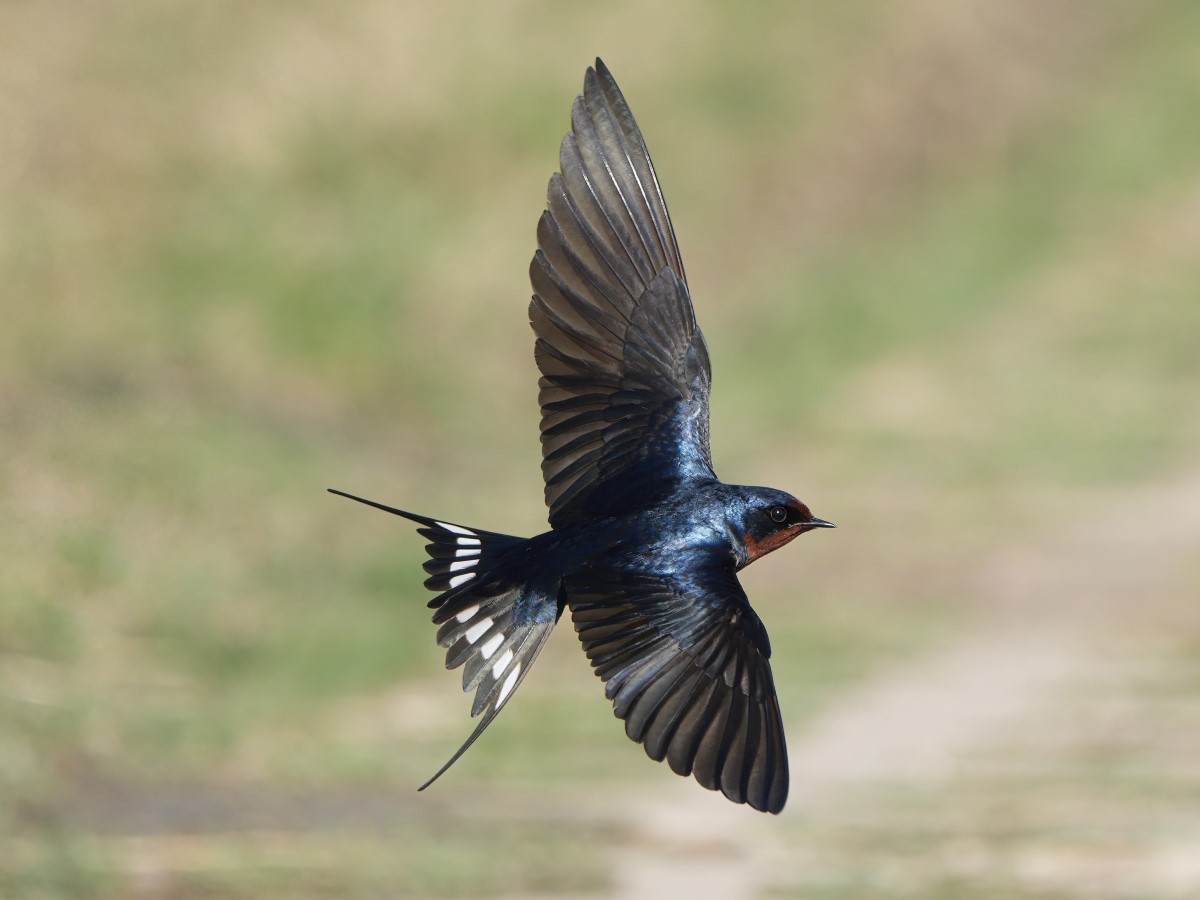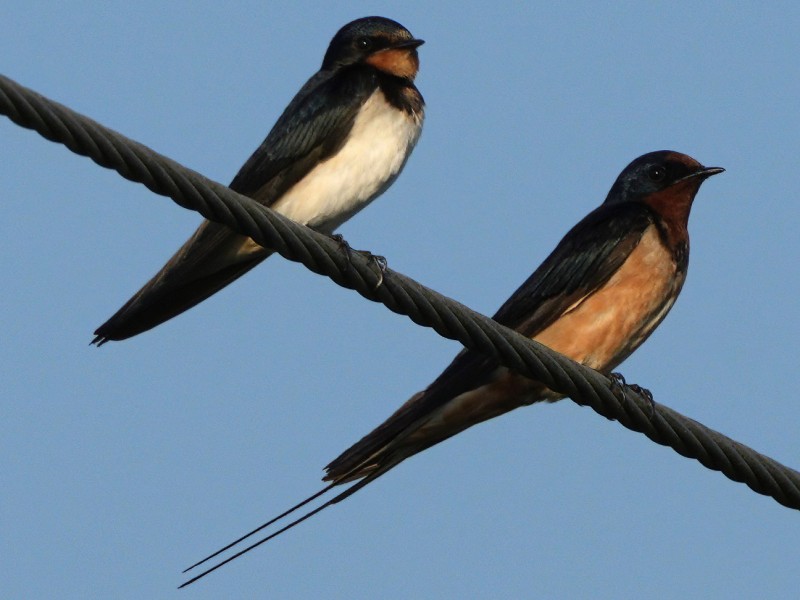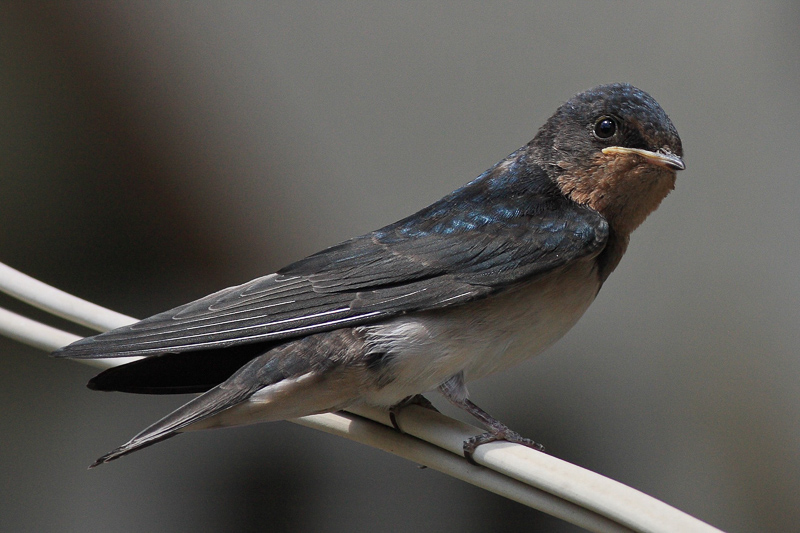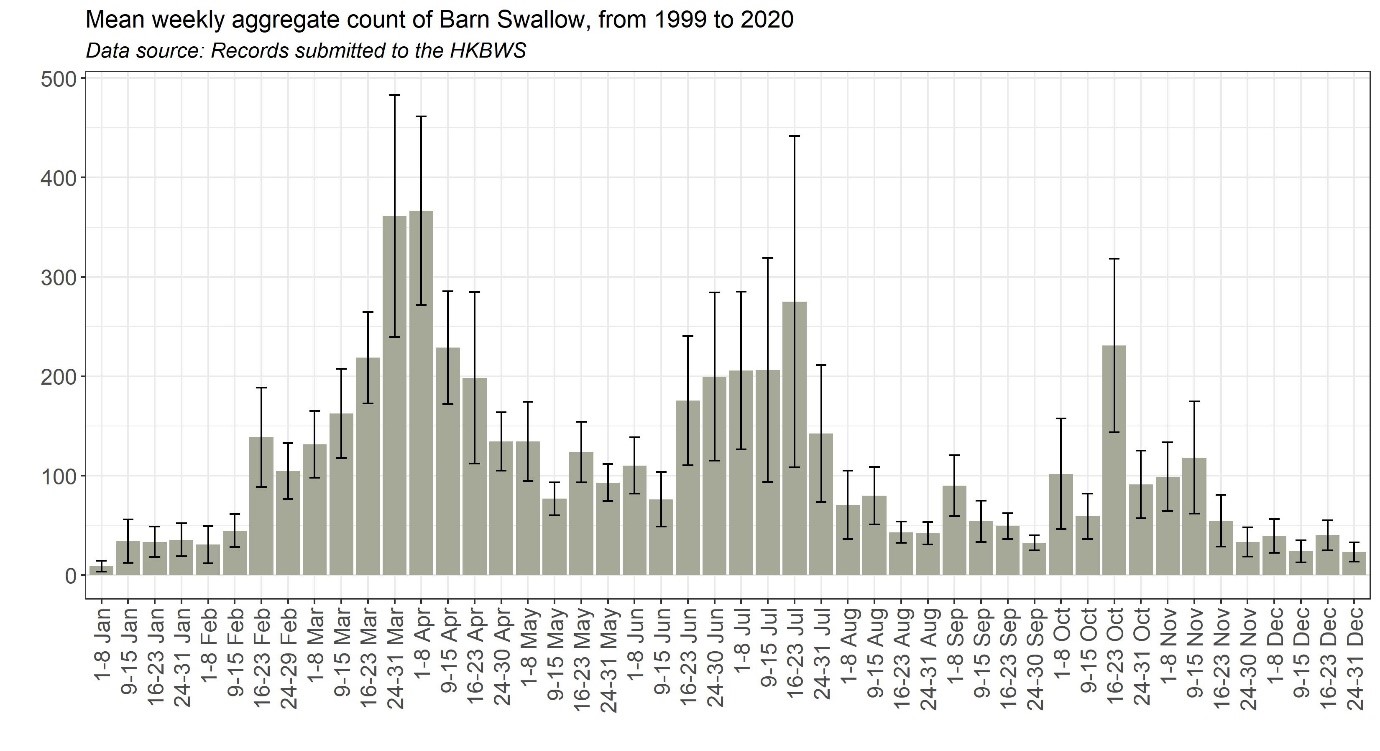Barn Swallow Hirundo rustica 家燕
Category I. Present all year and can be seen in all habitats. Numbers are highest in spring, followed by summer, autumn and winter in that order.
IDENTIFICATION

Mar. 2023, Paul Leader. Adult.
17-19 cm. Small aerial insectivore commonly seen for much of the year. The forehead and throat are dull reddish, bordered below by dark, often broken, blue band. In flight uses fewer glides than Red-rumped Swallow or Delichon martins.

Mar. 2023, Paul Leader. Adult.
Adults are dark blue above and have a long tail, each feather having a subterminal row of broad tail spots and the outer two elongated into long thin streamers.

Dec. 2024, Paul Leader.
Below the reddish throat and broken blue band, the underparts are creamy or faint buff in the taxon gutturalis. Birds with strongly buff underparts are sometimes seen, but it is unknown which taxon these are (see below).

Jul. 2008, Fung Hon Shing. Juvenile.
Juveniles have short tail streamers, a duller and paler colouration around the head, an obvious pale gape that darkens with age and dull upperparts.
VOCALISATIONS
A varied vocabulary, but the typical flight call is a single or double note inflected ‘tvit’ or tvit-it’, while the alarm call is a high-pitched double-note call, the first element shorter than the second; both are audible in this recording.
The song comprises extended chattering interspersed with buzzing notes.
DISTRIBUTION & HABITAT PREFERENCE
Barn Swallows forage over Deep Bay area wetlands at all times of year. On passage they are seen over marshes, agricultural land and wooded hillsides, while chiefly during the breeding season they can be seen over city parks, low-density village areas and gardens, when they nest in villages and in older urban areas. On passage, they are widespread. They are regularly reported in inshore waters and occasionally far out at sea (Hopkin 1990, Loynd 1992).
OCCURRENCE
Barn Swallow is a common migrant passing through in spring and autumn, a breeding bird and a wintering species in small numbers (Figure 1).
The largest flocks of migrant Barn Swallows are generally reported in the Deep Bay area in spring, especially during or ahead of northerly or easterly surges associated with the northeast monsoon. Flocks of hundreds, typically feeding over fish ponds, have been recorded from early March with peak numbers from mid-March to mid-April. The highest count at a single site is 3,000 at Mai Po on 2 April 1995, and the highest day count is 5,500 in the Deep Bay area on 4 April 1996. However, it appears that such counts may be lower now, with the highest since 1999 being 1,200 on 28 March 2004.
Less intense passage is observed in the second half of April. Flocks of several hundred are occasionally sighted in May and June when passage migrants become difficult to separate from the breeding population.
Autumn passage is protracted and is noted from August to November. Most reports during this period refer to flocks of 10-50, occasionally 500, the highest being 1,700 at Mai Po on 23 October 2017.
On Po Toi where Barn Swallow is predominantly a migrant, it has been recorded from 16 January to 1 June and from 6 August to 25 November. Although this reflects observer activity to some extent, with rather few observations in summer, it appears to be a fairly accurate reflection of passage timing through HK.
Counts carried out in 2015 and 2016 revealed a large population of Barn Swallows roosting in the summer in Sai Kung town, with the highest count being 1,082 on 5 July 2015; an even higher summer count of 2,500 roosting birds was made at Mai Po NR on 20 July 2007. Although such counts may indicate the local breeding population is larger than was previously known, it is likely that these concentrations include birds that breed regionally.
Barn Swallow is recorded annually in December and January, chiefly in fish pond areas of Deep Bay. Numbers at this time of year appear to have increased substantially. Until 1998 winter they were typically recorded in flocks of 10-20, occasionally more, with the highest count being 200 near Mai Po on 29 December 1985. However, since then the highest count is 1,000 on 20 February 2000, and there are regular counts of up to 200 birds.
Walker (1958) reported ‘rufous-bellied birds’ on 11th and 14 February and 16 March; since then further reports have extended the range of dates of occurrence from 2 January to 26 April. However, the taxon to which these birds belong is unclear.
No obvious changes in status are evident from the historical literature. Barn Swallow was first recorded in February and March 1860 by Swinhoe (1861) who noted nest-building.
BEHAVIOUR, FORAGING & DIET
Roosts communally outside the breeding season in reedbeds (highest count 2,500 at Mai Po NR) or on wires or building ledges (highest count 1,082 in Sai Kung). After breeding flocks of mainly juveniles gather in favoured areas to forage aerially, but there are no details on prey items.
BREEDING
Away from forest and shrubland, widespread breeding occurs, including on smaller offshore islands. The bulk of birds breed in the northwest and north New Territories, particularly in the Deep Bay area. The favoured building types are village houses or older medium-rise buildings such as those in Tai Po Market, both of which have balconies or overhanging rooves under which nests are constructed.
Breeding activity in some form has been noted in all months of the year, from the collection of mud for nest-building on 28 January to an adult on the nest on 7 December, and a separate record of four young on 8 December that had fledged a week later. In spring, many locally-breeding birds are on nests well before most migrants have passed through. First arrivals at breeding sites generally occur in the second half of February, while nest-building typically begins late February or early March. The earliest record of fledged young occurred in late February 1991, but generally juveniles are noted from late March and early April. Most breeding activity is over by mid-July.
Since up to 72 nests were found in one new town in the New Territories (Wong 1994) and 20 nests or more are recorded at some villages in the New Territories, the Hong Kong breeding population must number several thousand pairs. It appears, however, that this has declined as in the 1993-96 breeding bird survey approximately 50% of 1km squares were occupied, while in the 2016-19 survey this figure had reduced to 35%. Part of this decline is likely be due to older buildings being replaced by structures that lack overhanging roof structures.
Studies carried out in Palm Springs recorded 34 nests (2018) and 30 nests (2023) with eight (24%) and 12 (40%) nests double-brooded respectively. In both years peak numbers of young were recorded in May. The largest single brood was six chicks. Mean number of chicks per nest was 4.00 (S.D. +/- 1.38) in the first brood and 3.5 chicks (S.D. +/- 1.45) in the second brood from the 2023 study (D. J. Stanton pers. obs.).
Nesting birds have long been regarded as harbingers of good luck and received protection from local people in HK (Vaughan and Jones 1913, Wong 1994). Eviction from their nests by House Swifts was reported by Wong (1994) which have also been recorded under predation by Long-tailed Shrike.
RANGE & SYSTEMATICS
Nearly worldwide distribution, breeding from 20oN to 70oN in North America and Eurasia, and wintering largely south in South America, sub-Saharan Africa, the Indian subcontinent and Indochina south to northern Australia (Brown and Brown 2020). In China it is a summer visitor everywhere apart from high plateau areas in the west and is present all year in southern coastal areas including Hainan and Taiwan (Liu and Chen 2021).
The locally breeding taxon is H. r. gutturalis, which breeds from the east Himalayas to Korea, Japan, Taiwan and east and south China. Other taxa that could occur on passage are H. r. tytleri (breeds south central Siberia), H. r. saturata (east Siberia) and H. r. mandschurica (northeast China).
CONSERVATION STATUS
IUCN: Least Concern. Population trend decreasing.
Figure 1.

Brown, M. B. and C. R. Brown (2020). Barn Swallow (Hirundo rustica), version 1.0. In Birds of the World (P. G. Rodewald, Editor). Cornell Lab of Ornithology, Ithaca, NY, USA.
Hopkin, P. J. (1990). Seabird passage in the Strait of Taiwan, May 1989. Hong Kong Bird Report 1989: 131-135.
Liu, Y. and S. H. Chen (eds) (2021). The CNG Field Guide to the Birds of China (in Chinese). Hunan Science and Technology Publication House, Changsha.
Loynd, A. (1992). Bird observations in the East and South China Seas, April and May 1991. Hong Kong Bird Report 1991: 197.
Swinhoe, R. (1861). Notes on the ornithology of Hong Kong, Macao and Canton, made during the latter end of February, March, April and the beginning of May 1860. Ibis 1861: 23-57.
Vaughan, R. E. and K. H. Jones (1913). The birds of Hong Kong, Macao and the West River or Si Kiang in South-East China, with special reference to their nidification and seasonal movements. Ibis 1913: 17-76, 163-201, 351-384.
Walker, F. J. (1958). Field observations on birds in the Colony of Hong Kong. Hong Kong Bird Watching Society, Hong Kong (duplicated).
Wong, F. K. O. (1991). WWF Hong Kong survey of nesting swifts and swallows.

